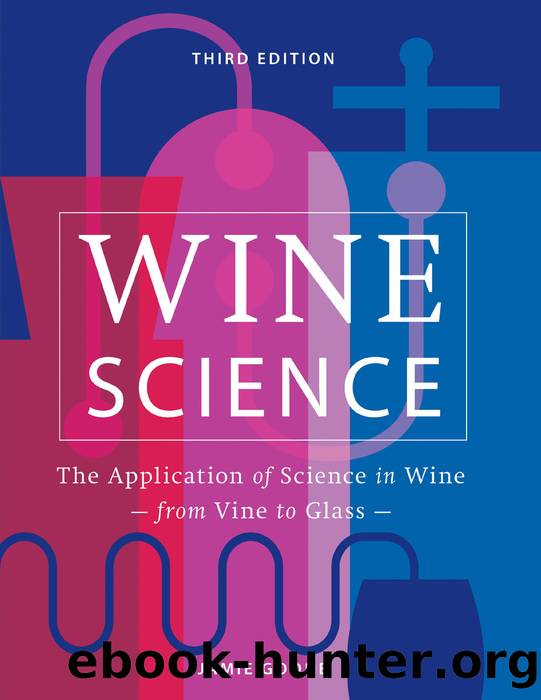The Science of Wine: From Vine to Glass â 3rd Edition by Jamie Goode

Author:Jamie Goode [Goode, Jamie]
Language: eng
Format: epub
ISBN: 9780520379503
Google: WDUoEAAAQBAJ
Amazon: 0520379500
Published: 2021-06-08T00:00:00+00:00
INOCULATING WITH LACTIC ACID BACTERIA
Traditionally, MLF has been rather unpredictable. It happens when it happens, and sometimes it happens after bottling, with disastrous consequences. To initiate the process, the population of LAB has to reach a threshold level of one million viable cells per milliliter (106 CFU/ml). Factors influencing this population growth include pH (it happens more easily at higher pH, but then the species and strains taking part will likely be a little different), the nutrient status of the wine, the temperature, and the strains of bacteria present. In many classic European regions, harvesting takes place in fall and cellars become increasingly cold as fermentation finishes, such that there is a long delay before malolactic fermentation, which takes place the following spring as the cellars warm up. This means a delay of several months between the completion of alcoholic fermentation and the onset of the malolactic conversion.
This delay between the end of alcoholic fermentation and the onset of MLF can be a risky time for red wines. This is because the wine is relatively unprotected from microbial growth because free sulfur dioxide levels are low or zero, creating ideal conditions for the growth of the spoilage yeast Brettanomyces. Winemakers are not able to use much sulfur dioxide at this stage because they risk inhibiting MLF altogether. This is why some choose to inoculate with bacterial cultures. Once MLF is finished, it is possible to add sulfur dioxide to protect the wine. But itâs a complicated business, because wines respond differently to the ingress of oxygen that barrel maturation permits depending on whether or not free sulfur dioxide is present at appreciable levels. Ãlevage is a complicated business, and perhaps as much an art as a science.
Another factor is whether or not to complete MLF in tank or barrel. A recent trend for high-end red wines has been to move them to barrel before MLF is fully complete, and then do MLF in barrel. Some winemakers, however, believe they get better results and more authentic wines by carrying out malolactic in tank before going to barrel.
The existence of frozen or freeze-dried cultures of O. oeni for starting MLF makes this choice a matter of winemaking style. Such frozen or freeze-dried cultures are added directly to the wineâin the past some cultures required a reconstitution stageâbut they are faced with quite a task, because they are being added to a fairly hostile environment. These cultures of O. oeni are selected for the ability to tolerate low pH and high ethanol, but they arenât selected for their resistance to sulfur dioxide because this would then make it tricky to stabilize the wine at a later stage. Single strains are best because combinations of strains may end up competing with one another.
A recent shift has been experimentation with co-inoculation of cultured yeast and LAB. There are clear advantages of completing alcoholic and MLF simultaneously for commercial wines, including reduced time in tank or barrel and reduced risk of unwanted microbial activity. However, the strains of yeast and bacteria need to be carefully matched in order for this to work.
Download
This site does not store any files on its server. We only index and link to content provided by other sites. Please contact the content providers to delete copyright contents if any and email us, we'll remove relevant links or contents immediately.
Craft Beer for the Homebrewer by Michael Agnew(18140)
Marijuana Grower's Handbook by Ed Rosenthal(3619)
Barkskins by Annie Proulx(3298)
Project Animal Farm: An Accidental Journey into the Secret World of Farming and the Truth About Our Food by Sonia Faruqi(3175)
The Plant Messiah by Carlos Magdalena(2881)
Red Famine: Stalin's War on Ukraine by Anne Applebaum(2872)
0041152001443424520 .pdf by Unknown(2783)
Organic Mushroom Farming and Mycoremediation by Tradd Cotter(2626)
In the Woods by Tana French(2529)
Beer is proof God loves us by Charles W. Bamforth(2370)
7-14 Days by Noah Waters(2359)
Reservoir 13 by Jon McGregor(2239)
Borders by unknow(2226)
Meathooked by Marta Zaraska(2220)
The Art of Making Gelato by Morgan Morano(2215)
Birds, Beasts and Relatives by Gerald Durrell(2175)
Between Two Fires by Christopher Buehlman(2163)
The 7 Habits of Highly Effective People: Powerful Lessons in Personal Change (25th Anniversary Edition) by Covey Stephen R(2135)
The Lean Farm Guide to Growing Vegetables: More In-Depth Lean Techniques for Efficient Organic Production by Ben Hartman(2096)
